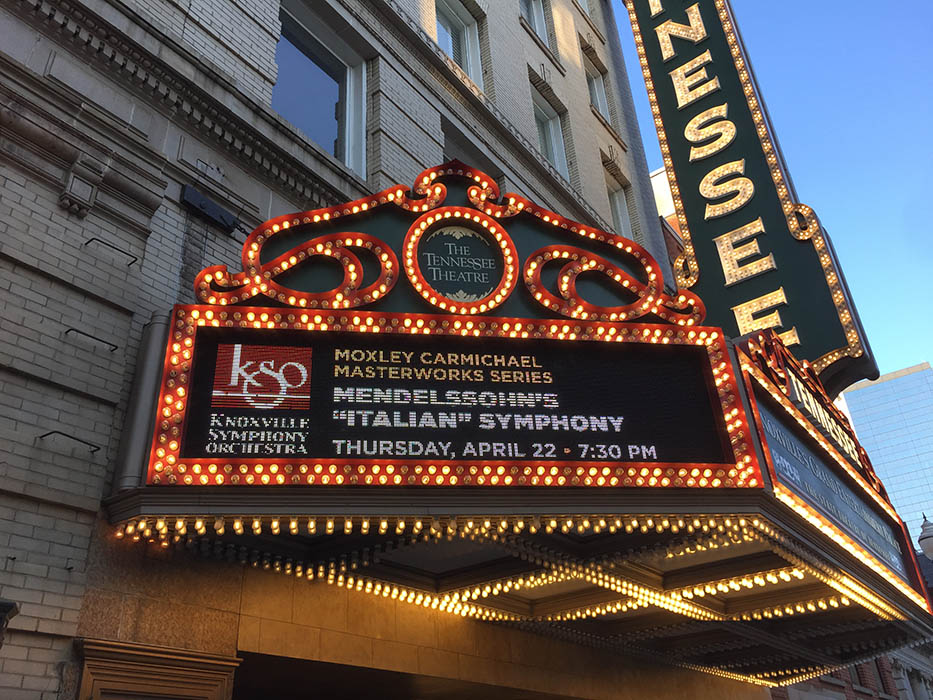When the Knoxville Symphony Orchestra announced its four-month hybrid season of limited-audience plus livestream performances beginning in February, even the most eager listeners, admittedly anxious for a return to the concert hall, probably visualized a large asterisk next to the season in the history books. After all, the core orchestra had not played together during the Covid-19 shutdown. Naturally, any reasonably knowledgable person would have surmised that an orchestra, reduced to a size able to fit on a stage with players spread apart, would inevitably show frayed musical edges from the compromised conditions. Would balance between sections, the reduced complement of strings, or shaky ensemble accuracy be a serious issue? Last evening’s eminently charming and joyfully focused Masterworks concert at the Tennessee Theatre proved that certainly hasn’t been the case.
KSO music director Aram Demirjian chose a program of three works which he admitted in his remarks had no specific theme other than “they sounded good together” as music for a spring evening. Without an intermission, as has been the procedure, the concert opened with Mendelssohn’s Symphony No. 4 (“Italian”), then jumped ahead chronologically to Ottorino Respighi’s Botticelli Triptych from 1927 and then to György Ligeti’s 1951 fusion of symphonic Romanian folk music and modern jazz-esque expressionism, Concert Românesc (Romanian Concerto).
For any anxious audience members—themselves masked and distanced and probably feeling like strangers in a strange land—that anxiety evaporated in Mendelssohn’s familiar sunny opening theme, played with certainty, energy, and an optimistic tempo. The second Andante movement and its careful pacing was appropriately processional and beautifully balanced between strings and woodwinds, removing any lingering doubts on that accord. The drama of the horns, bassoons, and flutes in the third movement was curiously moving, setting the stage for a marvelous and solid fourth movement that was a feast of Mendelssohn flute writing, played with an acrobatic exhilaration by KSO principal flute Jessica Petrasek.

It is impossible to mention Ottorino Respighi and not focus on his ubiquitous trio of tone poems, Fountains of Rome, Pines of Rome, and Roman Festivals, as well as The Birds. Unfortunately, this attention overshadows many other delightful works, the Botticelli Triptych on last evening’s concert certainly being one. Admittedly, the three movement work, inspired by three Botticelli paintings in the Uffizi Gallery (“La Primavera”, “”The Adoration of the Magi”, and “La nascita di Venere”), is more modest texturally than the Roman trio, and in its instrumental requirements. Nevertheless, there is still a feast of fascinating colorful orchestration that attempts through broad brush strokes and subtle details to reflect the emotions of the Botticelli paintings. This comes to the listener in terms of ancient musical images recast into a modern instrumental setting that strives for a tonal pictorialism. This pictorialism dictated some delicious solo opportunities for oboe (Claire Chenette), bassoon ( Zach Millwood), clarinet Gary Sperl, horn (Jeffery Whaley), flute (Jessica Petrasek).
[Ed: The KSO will be performing Pines of Rome next season, in January, 2022]
I’m not certain when (or if) I had last heard György Ligeti’s Concert Românesc (Romanian Concerto) performed live, so this concluding piece on the concert served as a real ear-opener and showcase of instrumental color-making from the KSO players. One was immediately taken by Maestro Demirjian’s demonstrative emphasis in the traditional-to-modern arc of the piece. The opening movement mixes string lyricism with woodwind details in a pastoral vein. The second movement is a brisk dance of solo violin (played vividly by concertmaster William Shaub), piccolo (Jill Bartine), and a host of percussion colors. The clarinets (Gary Sperl, Mark Tucker) carry over into the third movement that begins with two horns (Jeffery Whaley and Sean Donovan), one off-stage, in a suggestion of Alphorns. Shimmering strings back up the horns and plaintive assertions from the oboe (Claire Chenette) and English horn (Ayca Yayman), as well from the clarinet. By the fourth movement, any memory of a pastoral feel has been replaced with a curious fusion of modernism and Romanian folk melodies that break into a dance. This dance, tinged with full orchestra cacophony and punctuated by a bee-like solo violin, seduces the listener with repeated false endings, but inevitably ends the intrigue with a satisfying, perhaps joyous, crash. Kudos to the KSO and Maestro Demirjian for including this work and to the orchestra players who made it all work.
The KSO will continue the current practice of offering some limited seating for live audiences as well as live-streaming. Check the KSO website for information and tickets.








